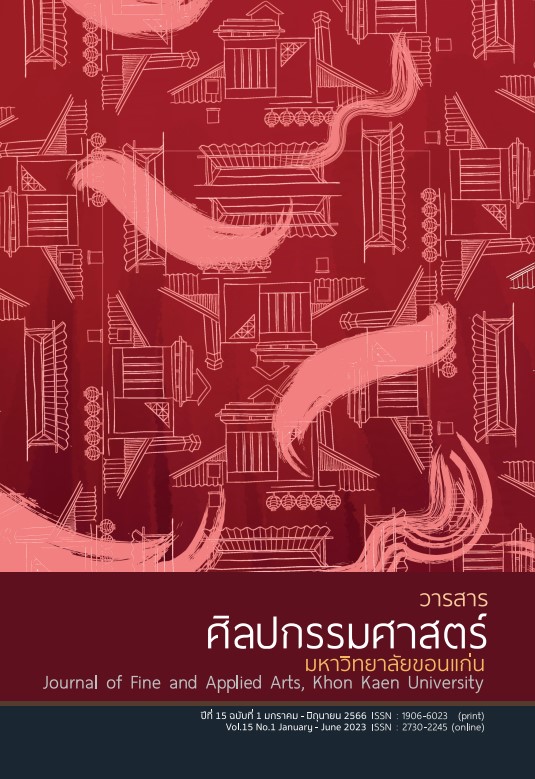Knowledge Management of Phasin (Tube Skirt) Nam Ang Weaving, Uttaradit Province by Participation of Communities for Sustainable Development
Main Article Content
Abstract
This research studied collecting knowledge of intangible cultural heritage and weaving knowledge management of Nam Ang community Uttaradit, and participation of the Nam Ang community Uttaradit in weaving phasin (tube skirt) network management to create sustainable development. Qualitative research was done with data collected from in-depth interviews with weavers in focus groups using semi-structured questions from the Prime Minister of Nam Ang Subdistrict Administrative Organization (NASAO). Additional data was collected from books, research papers, and related academic articles. Results were that intangible cultural heritage and community knowledge management knowledge collection consisted of 1) searching for Sin Tin Jok cloth weaving skill; 2) knowledge storage pertained to deep-seated weaving knowledge accumulated by the NASAO and recorded in writing; 3) knowledge transfer to subsequent generations of weavers permitted Nam Ang School students to learn weaving; and 4) knowledge application was used by the skill corpus; storing and exchanging knowledge; and improving operational efficiency, such as in using natural dyes. For community participation in creating network sustainability, a weaving network and community learning center were established as well as a market for selling products, producing sustainable community income.
Article Details

This work is licensed under a Creative Commons Attribution-NonCommercial-NoDerivatives 4.0 International License.
Content and information in articles published in the Journal of Fine and Applied Arts of Khon Kaen University is regarded as the opinion and sole responsibility of the author(s) directly; therefore, editors are not obliged to agree to or share any responsibility with regard to the content and information that appears within these articles.
All articles, information, content, image, etc. that have been published in the Journal of Fine and Applied Arts of Khon Kaen University is the copyright of the Journal of Fine and Appllied Arts of Khon Kaen University. Any person or organization who wishes to distribute all or parts of the articles for further dissemination or other usage must first receive permission from the Journal of Fine and Applied Arts of Khon Kaen University before proceeding to do so.
References
กรมควบคุมโรค. (2557). คู่มือการจัดการความรู้. กรุงเทพฯ : กลุ่มงานจัดการความรู้.
ฐิติยา เนตรวงษ์. (2563). แหล่งเรียนรู้ภูมิปัญญาท้องถิ่นกับการจัดการความรู้ด้วยไอซีที: จากห้องเรียนสู่ชุมชน. วารสารวิชาการครุศาสตร์อุตสาหกรรม พระจอมเกล้าพระนครเหนือ, 221-229.
สนธยา พลศรี. (2533). ทฤษฎีและหลักการพัฒนาชุมชน. กรุงเทพฯ : โอเดียนสโตร์.
สำนักงานคณะกรรมการพัฒนาการเศรษฐกิจและสังคมแห่งชาติ สำนักนายกรัฐมนตรี. (2559, 29 ธันวาคม). แผนพัฒนาเศรษฐกิจและสังคมแห่งชาติ. ค้นจาก https://www.nesdc.go.th/ewt_dl_link. php?nid=6422
เสรี พงศ์พิศ. (2548). เครือข่าย. กรุงเทพฯ : เจริญวิทย์การพิมพ์.
ข่าว 77 จังหวัด ไทยนิวส์. (2562, 2 ตุลาคม). ข่าวภูมิภาค 77 จังหวัด. ค้นจาก https://web.facebook.com/ localTnews/?_rdc=1&_rdr
Aler, C., & Hage, J. (1993). Organization working together. Califonia : Sage.
Jaidee, K., & Girdwichai, L. (2019). The Influence of social capital: Social network, localism, philosophy of sufficiency economy and knowledge management; towards sustainable community development in Samut Songkram Province. Journal of Research and Development Suan Sunandha Rajabhat University, 8, 37-49.
Ryoko, T. (2002). The importance of leadership in knowledge management: Knowlede management for corporate innovation. Tokyo : APO.
Wisawakul, N., Samuttai, R., Srisuk, K., & Sarobol, A. (2019). Strategic development for supportive the knowledge management for local wisdom of community enterprises Chiang Mai Province. Veridian E-Journal, Silpakorn University (Humanities, Social Sciences and arts), 12(2), 1323-1345.


